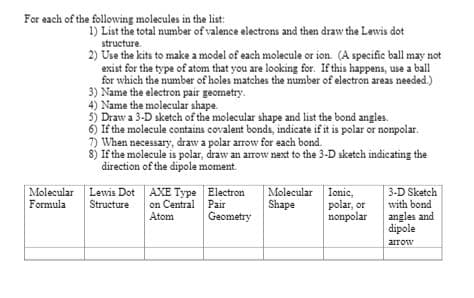For each of the following molecules in the list: 1) List the total number of valence electrons and then draw the Lewis dot structure. 2) Use the kits to make a model of each molecule or ion. (A specific ball may not exist for the type of atom that you are looking for. If this happens, use a ball for which the number of holes matches the number of electron areas needed.) 3) Name the electron pair geometry. 4) Name the molecular shape. 5) Draw a 3-D sketch of the molecular shape and list the bond angles. 6) If the molecule contains covalent bonds, indicate if it is polar or nonpolar. 7) When necessary, draw a polar arrow for each bond. 8) If the molecule is polar, draw an arrow nexst to the 3-D sketch indicating the direction of the dipole moment. Molecular Lewis Dot AXE Type Electron on Central Pair Atom Molecular lonic, polar, or nonpolar 3-D Sketch with bond angles and Formula Structure Shape Geometry di
Electronic Effects
The effect of electrons that are located in the chemical bonds within the atoms of the molecule is termed an electronic effect. The electronic effect is also explained as the effect through which the reactivity of the compound in one portion is controlled by the electron repulsion or attraction producing in another portion of the molecule.
Drawing Resonance Forms
In organic chemistry, resonance may be a mental exercise that illustrates the delocalization of electrons inside molecules within the valence bond theory of octet bonding. It entails creating several Lewis structures that, when combined, reflect the molecule's entire electronic structure. One Lewis diagram cannot explain the bonding (lone pair, double bond, octet) elaborately. A hybrid describes a combination of possible resonance structures that represents the entire delocalization of electrons within the molecule.
Using Molecular Structure To Predict Equilibrium
Equilibrium does not always imply an equal presence of reactants and products. This signifies that the reaction reaches a point when reactant and product quantities remain constant as the rate of forward and backward reaction is the same. Molecular structures of various compounds can help in predicting equilibrium.


Trending now
This is a popular solution!
Step by step
Solved in 4 steps with 1 images






